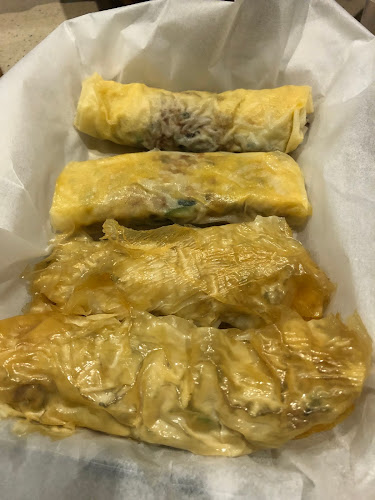I've learnt that there are two main styles of Castella, the original or Japanese Kastera カステラ, and the colonised adaptation which is Taiwanese Castella. Both are unique in their own way. Japanese Kasutera usually uses honey as the main flavour. The focus is on the moistness yet bounce achieved from bread flour through the use of an insulated or wooden container. It needs to rest overnight wrapped in plastic. Taiwanese Castella uses cake flour and focuses on bouncy sponginess. It is like making a chiffon and baked in a water bath. There is also a Korean version but it's mostly based off the Japanese version, so I'm going to ignore that. Tips and uniqueness of each recipe highlighted:
Japanese kastutera
1. Bake for Happy Kids (In her other recipes, she references recipes from Roti and Rice and Just One Cookbook)
- Loaf tin (20 by 10 cm); Lining tin with aluminium foil and parchment
- 3 eggs, separated
- Cook milk, oil, and honey before adding yolk and flour.
- Sugar at the bottom as optional
- All her attempts (adding extra yolk, omit oil, etc)
2. Just One Cookbook
- Possibly one of the original recipes
- 2 loaf tins (22 by 11cm), lined with parchment
- 6 eggs
- Beat eggs until ribbon stage and add flour
- Focuses on correct beating of eggs and variation of baking time to prevent cracks and sinking
3. Cooking with Dog
- Square tin (19 by 19cm). Very hard core, baked in a square cardboard box lined with alum foil and parchment, then sprinkle bottom with sugar
- 6 eggs
- Beat eggs and sugar in water bath until ribbon stage
4. Roti and Rice
- Loaf tin (19*9cm), lined with al foil and parchment
- 2 eggs, separated. Beat whites until meringue then add yolks and flour.
5. Not quite Nigella
- Loaf tin (26.5*7.5 cm), lined with parchment
- 3 eggs
- Whisk eggs and caster sugar on water bath
- Mixing meringue and flour layers well and quickly
- Most wrinkly looking cake
6. Taste Asian
- details differences between Taiwanese and Japanese version
- Lists common mistakes (use slow mixer speed for meringue, sifted flour for smooth batter, collapsed cake)
- Square (20 by 20 cm) tin, lined with corrugated cardboard with al foil or square tin with old newspapers.
- 7 eggs, separated
- Compares cakes that separate vs beat eggs together. Meringue method has finer texture and smoother.
- After separating eggs, beat whites on low speed on bain marie at 40 deg C until meringue forms. Add egg yolks manually, followed by honey and bread flour, and lastly, milk.
Taiwanese castella
Using butter
1. Emojoie Cuisine - Attempted here.
- Square tin (various sizes listed including 20cm), lined with non-stick parchment. Sounds super bouncy and moist
- 7 eggs separated for 20cm square tin
- Melt butter and milk to 50 deg C, add flour and yolks
- Very detailed recipe: beat the meringe at the end with hand whisk to stabilise meringue. Use hand whisk to incorporate first followed by spatula for final blending
2. Princess Bamboo
- 6" tin
- Uses flour and corn starch
- Uses butter but doesn't state the temperature to heat to
3. Gracious Treatz (very similar to Emojoie)
- 7" square tin, lined with parchment
- 6 eggs, separated
- Melt butter and milk to add to dough and yolks
- Re-usable non-stick parchment means no wrinkles
Using oil
4. Laura Kitchen
- 8" square tin, lined with parchment
- 5 eggs, separated
- Warm oil to between 70 to 85 deg C. Add flour, milk, eggs.
- Looks like very soft sponge that leaves fingerprints.
5. Mrs P's Kitchen
- 8" square tin, lined with parchment
- 6 eggs, separated
- Warm oil to 65 deg C. Add flour, egg yolks, and milk.
- Looks like a standard sponge and not super fluffy or bouncy
6. Kat Kwa
- 8" square tin
- 7 eggs separated
- Warm oil for 1 minute to 60 deg C. Add flour and cornstarch followed by milk.
- Looks like standard sponge and not super fluffy or bouncy
Korean chocolate castella
1. Apron Chocolate castella Attempted here.
- Loaf tin 29x7x10cm
- 6 eggs, separated
- Warm oil to between 60 to 70 deg C. Add flour, yolks, followed by milk.
- Looks like standard sponge and not super fluffy or bouncy
2. Korean Table Diary choc castella
- 16.5x16.5cm square tin
- 5 eggs, separated
- Heat oil for 1 minute on low (no temp given). Add flour, milk, yolks.
- Looks like a very bouncy soft sponge.



































